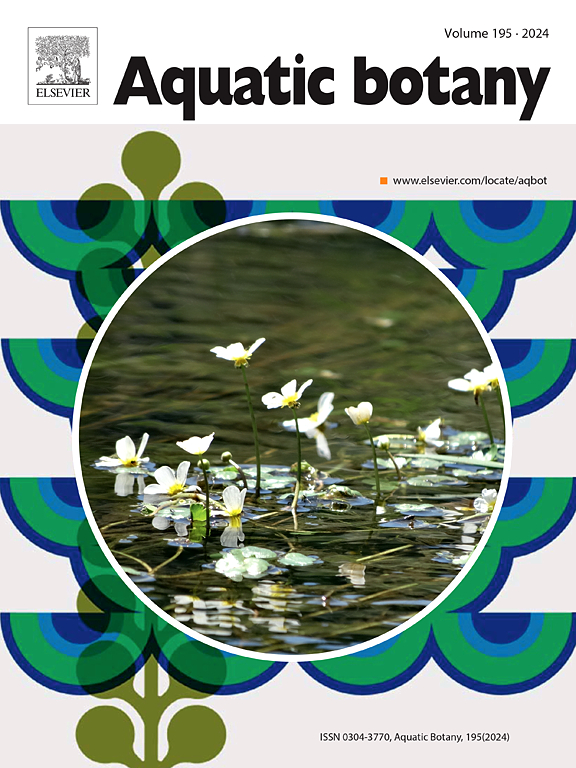红树蕨类植物紫菀叶性状和草食性:与巴西共生被子植物的比较研究
IF 2.6
4区 生物学
Q2 MARINE & FRESHWATER BIOLOGY
引用次数: 0
摘要
尽管它们具有生态学意义,但蕨类植物在草食和防御策略方面的研究仍不足,特别是在红树林生态系统中。本文分析了红树中常见的蕨类植物——金顶蕨(Acrostichum aureum)的叶片性状和草食危害,并与同一地区生长的两种被子植物——总状拉筋(Laguncularia racemosa)和根草(Rhizophora mangle)进行了比较。在本研究案例中,我们使用经典的视觉方法估计了巴西红树林中每个物种10至15个个体收集的100片叶子的草食性损害。我们测量了叶片厚度、养分(N、P、K和Ca)、重金属(Cd、Cr、Ni和Pb)和苯酚浓度,并使用方差分析对它们进行了比较。在所有研究物种中均未检测到Cd、Cr和Pb。我们的研究结果表明,与其他红树林物种相比,金葡萄具有更高的适口性,与较薄的叶子,缺乏Ni,较低的Ca和酚含量以及较高的NPK浓度有关。然而,金黄色葡萄球菌的草食伤害(0.05 %)明显低于总状乳杆菌(0.75 %)和曼格尔葡萄球菌(2.86 %)。因此,金黄色葡萄叶片的适口性并没有导致该物种较高的食草性伤害。我们的研究结果强调了推广叶片防御和营养成分对红树林物种食草性的影响的挑战。为了更好地了解其在红树林中的作用,我们鼓励在全球范围内收集金黄色葡萄球菌的草食数据。我们提出假设来解释为什么金黄色葡萄球菌的高适口性没有转化为高食草性。最后,我们强调在我们的研究区域缺乏自下而上的食草模式效应。本文章由计算机程序翻译,如有差异,请以英文原文为准。
Leaf traits and herbivory in the mangrove fern Acrostichum aureum: a comparative study case with co-occurring angiosperms in Brazil
Despite their ecological relevance, ferns remain understudied in terms of herbivory and defense strategies, especially in mangrove ecosystems. Here we analyzed the leaf traits and herbivory damage in Acrostichum aureum, a notable fern species occurring in mangroves, and compared the data with two angiosperms occurring in the same area, Laguncularia racemosa and Rhizophora mangle. For this study case, we estimated herbivory damage in 100 leaves collected from 10 to 15 individuals of each species in a Brazilian mangrove using the classical visual method. We measured the leaf thickness, nutrient (N, P, K and Ca), heavy metals (Cd, Cr, Ni, and Pb), and phenol concentrations and compared them using ANOVA. Cd, Cr, and Pb were not detected in all studied species. Our results demonstrated that A. aureum had higher palatability associated with thinner leaves, absence of Ni, lower Ca and phenol content, and higher NPK concentrations, compared to the other mangrove species. However, A. aureum exhibited significantly lower herbivory damage (0.05 %) than L. racemosa (0.75 %) and R. mangle (2.86 %). Therefore, the palatability of A. aureum leaves did not lead to higher herbivory damage in this species. Our findings underscore the challenges in generalizing the effects of leaf defenses and nutritional composition on herbivory in mangrove species. We encourage global herbivory data collection in A. aureum to better understand its role in mangrove herbivory. We propose hypotheses to explain why the high palatability does not translate into high herbivory in A. aureum. Finally, we highlight the absence of bottom-up effects on herbivory patterns in our study area.
求助全文
通过发布文献求助,成功后即可免费获取论文全文。
去求助
来源期刊

Aquatic Botany
生物-海洋与淡水生物学
CiteScore
3.80
自引率
5.60%
发文量
70
审稿时长
6 months
期刊介绍:
Aquatic Botany offers a platform for papers relevant to a broad international readership on fundamental and applied aspects of marine and freshwater macroscopic plants in a context of ecology or environmental biology. This includes molecular, biochemical and physiological aspects of macroscopic aquatic plants as well as the classification, structure, function, dynamics and ecological interactions in plant-dominated aquatic communities and ecosystems. It is an outlet for papers dealing with research on the consequences of disturbance and stressors (e.g. environmental fluctuations and climate change, pollution, grazing and pathogens), use and management of aquatic plants (plant production and decomposition, commercial harvest, plant control) and the conservation of aquatic plant communities (breeding, transplantation and restoration). Specialized publications on certain rare taxa or papers on aquatic macroscopic plants from under-represented regions in the world can also find their place, subject to editor evaluation. Studies on fungi or microalgae will remain outside the scope of Aquatic Botany.
 求助内容:
求助内容: 应助结果提醒方式:
应助结果提醒方式:


